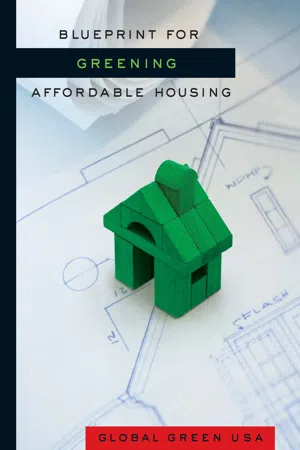
- 232 pages
- English
- ePUB (mobile friendly)
- Available on iOS & Android
Blueprint for Greening Affordable Housing
About This Book
Blueprint for Green Affordable Housing is a guide for housing developers, advocates, public agency staff, and the financial community that offers specific guidance on incorporating green building strategies into the design, construction, and operation of affordable housing developments. A completely revised and expanded second edition of the groundbreaking 1999 publication, this new book focuses on topics of specific relevance to affordable housing including:
- how green building adds value to affordable housing
- the integrated design process
- best practices in green design for affordable housing
- green operations and maintenance
- innovative funding and finance
- emerging programs, partnerships, and policies
Edited by national green affordable housing expert Walker Wells and featuring a foreword by Matt Petersen, president and chief executive officer of Global Green USA, the book presents 12 case studies of model developments and projects, including rental, home ownership, special needs, senior, self-help, and co-housing from around the United States. Each case study describes the unique green features of the development, discusses how they were successfully incorporated, considers the project's financing and savings associated with the green measures, and outlines lessons learned. Blueprint for Green Affordable Housing is the first book of its kind to present information regarding green building that is specifically tailored to the affordable housing development community.
Frequently asked questions
Information
CHAPTER 1
Making the Case for Green Affordable Housing
AFFORDABLE HOUSING
- Rental housing for very low-, low-, and moderate-income individuals and families
- For-sale housing for very low-, low-, and moderate-income individuals and families
- Housing for people with special physical or mental health needs
- Housing for people transitioning out of homelessness or medical or psychiatric institutions, or for emancipated foster youth leaving the family foster care system
- Housing for seniors
- “Sweat-equity” or self-help homes
WHAT IS GREEN BUILDING?
- 40 percent of U.S. energy use
- 35 percent of U.S. carbon dioxide production, a major contributor to global warming
- 30 percent of wood and raw materials
- 25 percent of water use
- 20 – 40 percent of solid waste
- Building in communities with existing services and infrastructure
- Reusing centrally located land and rehabilitating historic buildings
- Locating projects close to public transit and community amenities to reduce car dependency
- Producing the most compact and efficient units possible to reduce material use and the amount of space needing heating and cooling
- Reducing construction waste through materials reuse or recycling
- Reducing energy consumption through well-designed buildings and efficient appliances and fixtures
- Reducing water consumption both indoors and in landscaping
- Improving the quality and reducing the volume of stormwater
- Using materials that do minimal harm to people and the environment during manufacture, use, and disposal
- Increasing durability by minimizing moisture penetration.
- Improving indoor air quality through good ventilation and use of nontoxic materials and finishes
 FIGURE 1.1. Faison Mews Historic Rehabilitation (Camden, NJ). Photo courtesy of Darren Molnar-Port, NJDCA-NJ Green Homes Office FIGURE 1.2. Cambridge Co-Housing (Cambridge, MA). Photo courtesy of Bruce M. Hampton, AIA FIGURE 1.3. Colorado Court (Santa Monica, CA). Photo courtesy of Pugh + Scarpa Architects FIGURE 1.4. El Paseo Studios (San Jose, CA). Photo courtesy of First Community Housing
FIGURE 1.1. Faison Mews Historic Rehabilitation (Camden, NJ). Photo courtesy of Darren Molnar-Port, NJDCA-NJ Green Homes Office FIGURE 1.2. Cambridge Co-Housing (Cambridge, MA). Photo courtesy of Bruce M. Hampton, AIA FIGURE 1.3. Colorado Court (Santa Monica, CA). Photo courtesy of Pugh + Scarpa Architects FIGURE 1.4. El Paseo Studios (San Jose, CA). Photo courtesy of First Community Housing - Reducing the heat island effect through reflective roof and paving and planting trees.
- Establishing maintenance practices that reduce use of pesticides, fertilizers, and harmful cleaning chemicals.
THE BENEFITS OF GREEN BUILDING TO AFFORDABLE HOUSING
Table of contents
- ABOUT ISLAND PRESS
- Title Page
- Copyright Page
- Table of Contents
- ACKNOWLEDGMENTS
- FOREWORD
- CHAPTER 1 - Making the Case for Green Affordable Housing
- CHAPTER 2 - The Integrated Design Process
- CHAPTER 3 - Best Practices in Green Design
- CASE STUDIES
- CHAPTER 4 - Green Operations and Maintenance
- CHAPTER 5 - Costs and Financing
- CHAPTER 6 - Looking Forward: Programs, Partnerships, and Policies
- APPENDIX A - Resources
- APPENDIX B - Glossary
- APPENDIX C - Lease Addendum Example
- APPENDIX D - Solar RFP Example
- INDEX
- ISLAND PRESS BOARD OF DIRECTORS